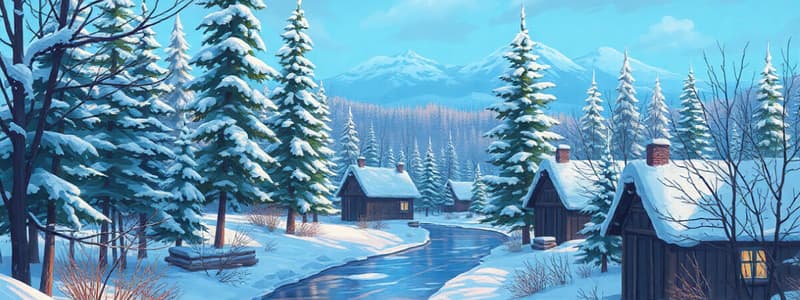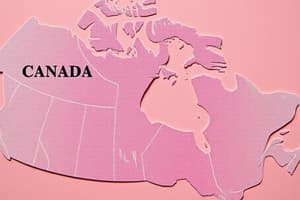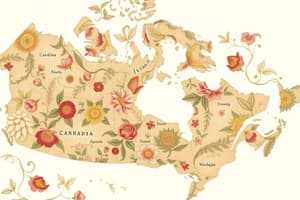Podcast
Questions and Answers
Why does the windchill factor differ from the actual temperature in weather reports?
Why does the windchill factor differ from the actual temperature in weather reports?
- Because weather reports intentionally misrepresent the true temperature to prepare residents for the worst conditions.
- Because windchill only measures the temperature at high altitudes, not at ground level.
- Because windchill only considers the temperature's impact on inanimate objects, not on living beings.
- Because windchill accounts for the cumulative effect of temperature, air speed, and humidity on the body's perception of cold. (correct)
Based on the information provided, what can be inferred about the climate of Eureka, Nunavut?
Based on the information provided, what can be inferred about the climate of Eureka, Nunavut?
- It is characterized by extremely cold temperatures, especially in February. (correct)
- It has milder winters compared to other regions in Canada due to warmer air currents.
- It experiences frequent heavy hailstorms due to its proximity to Saskatchewan.
- It is known for record-breaking snowfall events, particularly in late winter.
What is the significance of the winter solstice mentioned in the text?
What is the significance of the winter solstice mentioned in the text?
- It marks the beginning of the Québec Winter Carnival and the arrival of Bonhomme.
- It is the day when groundhogs emerge to predict the arrival of early spring.
- It is celebrated as the anniversary of the coldest temperature ever recorded in Snag, Yukon.
- It signifies the day with the fewest hours of sunlight and the most darkness due to the Northern Hemisphere's tilt away from the sun. (correct)
What can be concluded from the fact that Ottawa's Rideau Canal transforms into a skating rink each winter?
What can be concluded from the fact that Ottawa's Rideau Canal transforms into a skating rink each winter?
Which winter-related event depends on an animal's behavior to predict the upcoming season?
Which winter-related event depends on an animal's behavior to predict the upcoming season?
How do the distinct seasons in Canada most significantly impact its residents?
How do the distinct seasons in Canada most significantly impact its residents?
Which of the following best describes the typical characteristics of winter across Canada?
Which of the following best describes the typical characteristics of winter across Canada?
Why do weather forecasters in Canada issue extreme cold weather alerts?
Why do weather forecasters in Canada issue extreme cold weather alerts?
What contributes to the harsh winter conditions experienced in Canada's northern territories?
What contributes to the harsh winter conditions experienced in Canada's northern territories?
What distinguishes Winnipeg from other major Canadian cities during winter?
What distinguishes Winnipeg from other major Canadian cities during winter?
What is a key characteristic of winter in Victoria and Vancouver, compared to the rest of Canada?
What is a key characteristic of winter in Victoria and Vancouver, compared to the rest of Canada?
Which statement accurately connects a winter condition with a winter activity that occurs in Canada?
Which statement accurately connects a winter condition with a winter activity that occurs in Canada?
What is the best inference of Canada's winter from the information provided?
What is the best inference of Canada's winter from the information provided?
Flashcards
Coldest Temperature in Canada
Coldest Temperature in Canada
The lowest recorded temperature in Canada, reaching -63°C.
Windchill Factor
Windchill Factor
Takes into account temperature, air speed, and humidity to reflect how cold it feels.
Winter Solstice
Winter Solstice
The day with the fewest hours of sunlight in December.
Groundhog Day
Groundhog Day
Signup and view all the flashcards
Carnaval de Québec
Carnaval de Québec
Signup and view all the flashcards
Season
Season
Signup and view all the flashcards
Official Winter (Canada)
Official Winter (Canada)
Signup and view all the flashcards
Winter Characteristics (Canada)
Winter Characteristics (Canada)
Signup and view all the flashcards
Types of Winter Precipitation
Types of Winter Precipitation
Signup and view all the flashcards
Extreme Cold Weather Alerts
Extreme Cold Weather Alerts
Signup and view all the flashcards
Harsh winter conditions
Harsh winter conditions
Signup and view all the flashcards
Canadian Winter Sports
Canadian Winter Sports
Signup and view all the flashcards
Study Notes
Winter in Canada
- Most of Canada has four seasons: spring, summer, fall, and winter.
- Seasons last several months and have unique weather patterns.
- Changes in temperature influence clothing and activities.
- Winter officially lasts from mid-December to mid-March.
- Winter conditions can last longer depending on the region.
- Winter includes decreased daylight, cool temperatures, and increased precipitation.
- The four main types of winter precipitation are rain, freezing rain, snow, and sleet.
- Extreme cold weather alerts are issued to warn of the dangers of prolonged exposure on cold days.
- The harshest winter conditions are in the north, with temperatures averaging -30°C and colder.
- Winter temperatures can reach -40°C, not accounting for windchill.
- Wind, snow, frigid temperatures, and darkness are characteristic of northern Canada.
- The Northern Lights can be seen in Canada's northern territories.
Temperatures across Canada
- Winnipeg is one of the coldest major cities in Canada.
- Winter temperatures in Winnipeg are often below zero, with nearly 50 days averaging around -20°C.
- There is at least 1 cm of snow on the ground for nearly one third of the year in Winnipeg.
- Victoria and Vancouver have the mildest winters in Canada.
- Temperatures in Victoria and Vancouver remain at or above freezing, and rain is more common than snow.
- It rarely snows in Vancouver and Victoria, and when it does, it rarely sticks to the ground.
Winter Activities and Weather Reports
- Many Canadians enjoy winter sports like ice skating, ice fishing, snowshoeing, skiing, and snowboarding.
- Weather reports differentiate between actual temperature and windchill.
- Windchill accounts for the cumulative effect of temperature, air speed, and humidity on how the body feels.
Winter Records
- Lowest temperature: -63°C in Snag, Yukon, February 3rd, 1947.
- Lowest windchill reading: -79°C in Kugaaruk, Nunavut, January 13th, 1975.
- Coldest month: -50.1°C in Eureka, Nunavut, February 1979.
- Greatest snowfall in 24 hours: 145 cm in Tahtsa Lake, British Columbia, February 11th, 1999.
- Heaviest hailstone: 290 g in Cedoux, Saskatchewan, August 27th, 1973.
Fun Facts
- Ottawa is the seventh coldest capital city in the world.
- Ottawa receives an annual snowfall average of 236 cm.
- The Rideau Canal freezes every winter and becomes one of the longest outdoor skating rinks.
- Quebec City hosts the Carnaval de Québec from late January to early February.
- Bonhomme, a snowman, is the official mascot of the Québec Winter Carnival since 1954.
- Québec City is home to the Hôtel de Glace, the only ice hotel in North America.
- Canada has hosted the Winter Olympics twice: Calgary in 1988 and Vancouver in 2010.
- The winter solstice, the day with the fewest hours of sunlight, occurs in December due to the Northern Hemisphere tilting away from the sun.
- Groundhog Day is on February 2nd, where it is believed that if the groundhog sees its shadow, there will be six more weeks of winter.
Studying That Suits You
Use AI to generate personalized quizzes and flashcards to suit your learning preferences.




